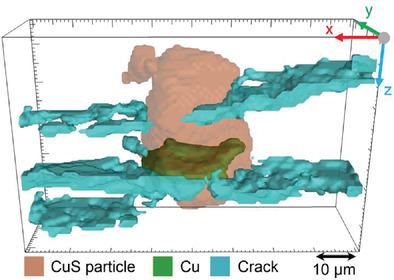当前位置:
X-MOL 学术
›
Adv. Energy Mater.
›
论文详情
Our official English website, www.x-mol.net, welcomes your feedback! (Note: you will need to create a separate account there.)
Phase Transformation and Microstructural Evolution of CuS Electrodes in Solid-State Batteries Probed by In Situ 3D X-Ray Tomography
Advanced Energy Materials ( IF 27.8 ) Pub Date : 2022-11-28 , DOI: 10.1002/aenm.202203143 Zhenggang Zhang 1 , Kang Dong 2 , Katherine A. Mazzio 1, 2 , André Hilger 2 , Henning Markötter 2, 3 , Fabian Wilde 4 , Tobias Heinemann 1 , Ingo Manke 2 , Philipp Adelhelm 1, 2
Advanced Energy Materials ( IF 27.8 ) Pub Date : 2022-11-28 , DOI: 10.1002/aenm.202203143 Zhenggang Zhang 1 , Kang Dong 2 , Katherine A. Mazzio 1, 2 , André Hilger 2 , Henning Markötter 2, 3 , Fabian Wilde 4 , Tobias Heinemann 1 , Ingo Manke 2 , Philipp Adelhelm 1, 2
Affiliation

|
Copper sulfide shows some unique physico-chemical properties that make it appealing as a cathode active material (CAM) for solid-state batteries (SSBs). The most peculiar feature of the electrode reaction is the reversible formation of µm-sized Cu crystals during cycling, despite its large theoretical volume change (75%). Here, the dynamic microstructural evolution of CuS cathodes in SSBs is studied using in situ synchrotron X-ray tomography. The formation of µm-sized Cu within the CAM particles can be clearly followed. This process is accompanied by crack formation that can be prevented by increasing the stack pressure from 26 to 40 MPa. Both the Cu inclusions and cracks show a preferential orientation perpendicular to the cell stack pressure, which can be a result of a z-oriented expansion of the CAM particles during lithiation. In addition, cycling leads to a z-oriented reversible displacement of the cathode pellet, which is linked to the plating/stripping of the Li counter electrode. The pronounced structural changes cause pressure changes of up to 6 MPa within the cell, as determined by operando stack pressure measurements. Reasons for the reversibility of the electrode reaction are discussed and are attributed to the favorable combination of soft materials.
中文翻译:

通过原位 3D X 射线断层扫描探测固态电池中 CuS 电极的相变和微观结构演变
硫化铜显示出一些独特的物理化学性质,使其成为固态电池 (SSB) 的阴极活性材料 (CAM)。电极反应最奇特的特征是在循环过程中可逆地形成 µm 尺寸的 Cu 晶体,尽管其理论体积变化很大 (75%)。在这里,使用原位同步加速器 X 射线断层扫描研究了 SSB 中 CuS 阴极的动态微观结构演变。可以清楚地看到 CAM 颗粒内 µm 级铜的形成。这个过程伴随着裂纹的形成,可以通过将堆叠压力从 26 MPa 增加到 40 MPa 来防止裂纹的形成。Cu 夹杂物和裂纹都显示出垂直于电池堆压力的优先取向,这可能是锂化过程中 CAM 颗粒在 z 方向膨胀的结果。此外,循环导致阴极颗粒的 z 向可逆位移,这与 Li 对电极的电镀/剥离有关。显着的结构变化导致电池内的压力变化高达 6 MPa,这由操作堆压力测量确定。讨论了电极反应可逆性的原因,归因于软材料的有利组合。
更新日期:2022-11-28
中文翻译:

通过原位 3D X 射线断层扫描探测固态电池中 CuS 电极的相变和微观结构演变
硫化铜显示出一些独特的物理化学性质,使其成为固态电池 (SSB) 的阴极活性材料 (CAM)。电极反应最奇特的特征是在循环过程中可逆地形成 µm 尺寸的 Cu 晶体,尽管其理论体积变化很大 (75%)。在这里,使用原位同步加速器 X 射线断层扫描研究了 SSB 中 CuS 阴极的动态微观结构演变。可以清楚地看到 CAM 颗粒内 µm 级铜的形成。这个过程伴随着裂纹的形成,可以通过将堆叠压力从 26 MPa 增加到 40 MPa 来防止裂纹的形成。Cu 夹杂物和裂纹都显示出垂直于电池堆压力的优先取向,这可能是锂化过程中 CAM 颗粒在 z 方向膨胀的结果。此外,循环导致阴极颗粒的 z 向可逆位移,这与 Li 对电极的电镀/剥离有关。显着的结构变化导致电池内的压力变化高达 6 MPa,这由操作堆压力测量确定。讨论了电极反应可逆性的原因,归因于软材料的有利组合。



























 京公网安备 11010802027423号
京公网安备 11010802027423号